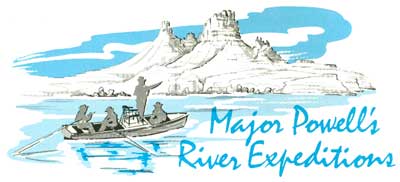
|
Geological Survey Bulletin 1327
The Geologic Story of Canyonlands National Park |
MAJOR POWELL'S RIVER EXPEDITIONS

Although Major John Wesley Powell was not the first geologist to view the canyon lands, his two daring boat trips down the Green and Colorado Rivers in 1869 and 1871 made history by bringing to light the first descriptions of the geography and geology of what was then the largest remaining uncharted wilderness in the United States. Many landmarks along the canyons in the park were named by Powell and his men during those explorations. J. S. Newberry is thought to have been the first geologist to view the canyon lands—at least he seems to have been the first one whose observations were recorded (1861), but the more comprehensive findings of Powell (1875) were the ones that made history.
The 100th anniversary of Major Powell's pioneer exploration of the Green and Colorado Rivers was commemorated in 1969 by a national centennial sponsored jointly by the U.S. Department of the Interior, the Smithsonian Institution, the National Geographic Society, and many other organizations. This touched off many magazine and newspaper articles, several commemorative programs and dedications, and several publications of lasting interest. Noteworthy among the latter is U.S. Geological Survey Professional Paper 669 entitled "The Colorado River Region and John Wesley Powell." Of its four separate parts, two are of special interest to our Canyonlands story: part A, "John Wesley Powell: Pioneer Statesman of Federal Science," by Rabbitt (1969) and part C, "Geologic History of the Colorado River," by Hunt (1969). An interesting history of the National Park Service by Everhart (1972) was published as part of the national park centennial effort. The Powell Society, Ltd., of Denver, Colo., was founded mainly to publish four "River Runners' Guides to the Canyons of the Green and Colorado Rivers, with Emphasis on Geologic Features," covering five reaches of the two rivers from Flaming Gorge Dam, Utah, to Grand Canyon, Ariz. One of these by Mutschler (1969) covers Labyrinth, Stillwater, and Cataract Canyons, all in Canyonlands National Park. Another guidebook by Baars and Molenaar (1971) covers the Colorado River from about Potash, Utah, to the confluence with the Green, and Cataract Canyon. It is difficult to realize that thousands of people annually now boat down the canyons Powell dared to explore without knowledge of the dangers that lay ahead.
During the summer of 1968 a U.S. Geological Survey expedition led by Eugene M. Shoemaker retraced the historic 1869 and 1871 river voyages of Major Powell, in order to reoccupy the camera stations of the 1871 voyage and rephotograph the same scenes nearly 100 years later. Remarkably enough, about 150 camera stations were recovered, many requiring considerable search, and official photographer Hal G. Stephens rephotographed the scenes taken with cumbersome wet-plate cameras nearly 100 years earlier by E. O. Beaman (above the site of Lees Ferry) and by J. K. Hillers (below the site). A report containing these remarkable sets of before and after photographs hopefully will be published eventually as a delayed part of the Powell centennial. A few pairs have been published by others (Baars and Molenaar, 1971, p. 90-99), and two pairs are shown herein as figures 62 and 67. As these photographs show, in most places the rocks and even the vegetation remain virtually unchanged after nearly a century, but a few other pairs not included herein show catastrophic changes resulting from local floods or rockfalls.
On June 26, 1969, state and local officials met along the Green River at the mouth of Split Mountain Canyon, in Dinosaur National Monument, to dedicate a monument to Major Powell, commemorating the 100th anniversary of his first river trip, and to dedicate the Powell Centennial Scenic Drive, also known as the Powell Memorial Highway. In the absence of any roads closely paralleling the Green and Colorado Rivers except for short distances, this route is virtually the only means of approach to the rivers and comprises parts of several state and federal highways connecting Green River, Wyo., and Grand Canyon, Ariz. A segment of it, U.S. Highway 163, connects Crescent Junction, Moab, Monticello, and Blanding, all in Utah, and provides the principal access routes to Canyonlands and Arches National Parks and Natural Bridges National Monument.
The ceremonies at the mouth of Split Mountain Canyon began with the landing of the official party flotilla of four boats similar to the ones used 100 years earlier by Powell, who was impersonated by a bearded man dressed to resemble the one-armed major. After the dedication, the four boats resumed the voyage down the Green River for another ceremony.
On June 29 a second monument was dedicated at the head of Desolation Canyon, some 50 miles southwest of Vernal, Utah, where the 1869 Powell expedition first ventured into the then unknown wilderness. The bronze plaque identifies Desolation Canyon, named by Powell, as a national historic landmark that comprises 58,000 acres in an area 1 mile wide on each side of a 95-mile reach of the Green River.

| <<< Previous | <<< Contents >>> | Next >>> |
bul/1327/sec2.htm
Last Updated: 28-Dec-2006